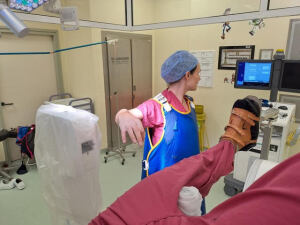Inadequate PPE puts female radiology workers at greater risk of developing breast cancer
by
John R. Fischer, Senior Reporter | April 14, 2023

Inadequate PPE puts women working in radiology and other medical specialties exposed to ionizing radiation at greater risk of developing breast cancer.
Due to inadequate personal protective equipment (PPE), women working around X-ray equipment and other medical imaging modalities are at increased risk of developing breast cancer from continual exposure to radiation.
PPE in radiology consists of lead gowns that are meant to protect the body from radiation, covering the torso, reproductive organs, and femurs, and offering additional thyroid protection. But these garments leave the most common area where breast cancer develops, the upper outer quadrant and axilla, which is close to the armpit, exposed, according to British researchers in a new study.
Using artificial female torsos, the scientists measured radiation exposure, finding that PPE for the upper outer quadrant was not as foolproof as other protected areas, with no statistically significant reduction in dose compared to exposing the torso to radiation without PPE.
Studies have shown that U.S. orthopedic surgeons face a 2.9-fold to 3.9-fold increase in developing breast cancer, compared to an age-matched female population, as well as increased risks among U.S. and Chinese radiological technologists. In a small study in Finland, researchers also found breast cancer to be 1.7 times the expected rate among radiologists, surgeons and cardiologists, compared to female physicians who do not work in radiation specialties.
For better protection, the authors suggest axillary shield sleeves that can be worn under standard gowns, gowns with capped sleeves, and axillary wings, finding in their study that these garments decreased intraoperative irradiation to the upper quadrant by 99%.
"In addition to wearing appropriate PPE (personal protective equipment) in the form of a well fitting gown that provides adequate coverage (and a thyroid shield) our mantra is stand as far back from the source as possible, keep arms by side when able, stand square to the source to avoid exposing the axilla, and reduce the use of direct lateral view," study author Dr. Deborah Eastwood, Cons Orthopaedic Surgeon and president of the British Orthopaedic Association, told HCB News.
According to Ionising Radiation Regulations 2017, radiation dose exposure among all workers should be As Low As Reasonably Achievable (ALARA), which the authors say is possible by reducing the duration of exposure, increasing distance from the source, and shielding all workers with effective PPE.
This supports the European Society for Vascular Surgery 2023 Clinical Practice Guidelines on Radiation Safety, which recommend that female operators consider adopting these extra forms of protection listed by the authors in their study. Additionally, the authors point out that employers are legally required to provide appropriate protection to all workers exposed to radiation, and should do this especially for women as the female breast is particulary vulnerable.
|
|
|
You Must Be Logged In To Post A Comment
|
